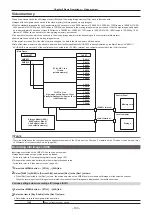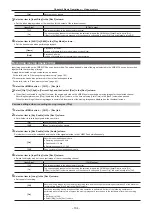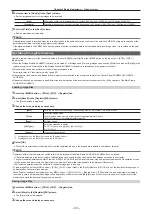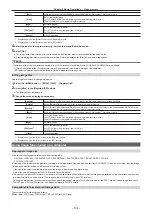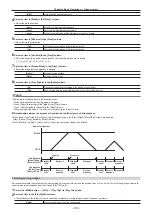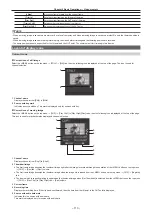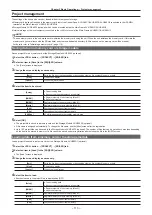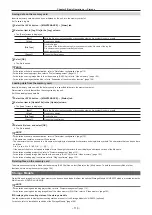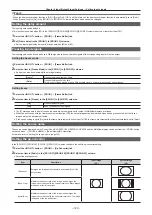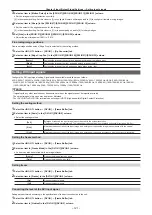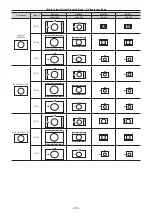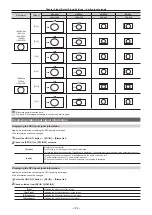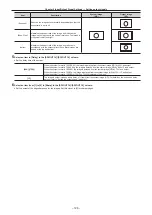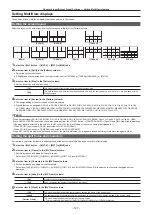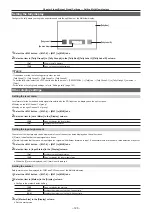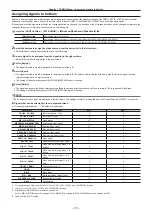
– 116 –
Chapter 5 Basic Operations — Storage
Saving data on the memory card
Insert the memory card which has been initialized by the unit, into the memory card slot.
Ex) To save a log file
1
Select the <SYS> button
→
[MAINTENANCE]
→
[Alarm] tab.
2
Select an item in [Log File] in the [Log] column.
f
The [Save] screen is displayed.
[Sort]
Sorts the file icon view in ascending or descending order by file number, file name, or date.
[View]
Fixed to icon display.
[File Type]
Fixed to file type.
The name of the folder where a log file is saved becomes the file name of the log file.
File names are assigned automatically as follows.
hs001.log to hs100.log
[Cancel]
Closes the [Save] screen.
3
Select [OK].
f
The file is saved.
@
@
NOTE
t
For details on the data save destination, refer to “Data folder configuration” (page 115).
t
For details on saving project files, refer to “Project management” (page 113).
t
t
For details on saving activation files, refer to “Expansion of the chroma key function” (page 158).
Loading data from the memory card
Insert the memory card on which the data is saved in a specified folder into the memory card slot.
Data stored in other folders will not be recognized by the unit.
Ex) When loading the update file
1
Select the <SYS> button
→
[MAINTENANCE]
→
[Status] tab.
2
Select an item in [Update File] in the [Update] column.
f
The [Load] screen is displayed.
[Sort]
Sorts the file icon view in ascending or descending order by file number, file name, or date.
[View]
Fixed to icon display.
[File Type]
Fixed to file type.
[Cancel]
Closes the [Load] screen.
3
Select a file icon, and select [OK].
f
The file is loaded.
@
@
NOTE
t
For details on the data save destination, refer to “Data folder configuration” (page 115).
t
A file name can contain a maximum 32 characters.
t
The characters that can be used in a file name are single‑byte alphanumeric characters and single‑byte symbols. The characters that can be used are
as follows.
A to Z, a to z, 0 to 9, ! # $ % & ' ( ) - . @ ^ _ ` { }
t
If the name of the file to be loaded consists of more than eight characters, the unit displays a shortened version of the file name.
t
For details on loading project files, refer to “Project management” (page 113).
t
t
For details on loading plug-in software, refer to “Plug-in software” (page 172).
Deleting files on the memory card
To delete unnecessary project files and video memory (Still, Clip) files, select [Delete] on the [Misc] screen. To delete unnecessary files of other
functions, delete using the computer. (page 106)
Storage Module
Project files and image files in the video memory can be saved and loaded in/from the optional Storage Module AV‑HS60D1 which is mounted inside the
Main Frame AV-HS60U1/AV-HS60U2.
@
@
NOTE
t
For details on saving and loading project files, refer to “Project management” (page 113).
t
r
Displaying the mounting status of the storage module
Use the system menu to display the mounting status on the unit of the Storage Module AV-HS60D1 (optional).
For details, refer to “Installation condition of the Storage Module” (page 158).
Summary of Contents for AV-HS60C1E
Page 5: ...Please read this chapter and check the accessories before use Chapter 1 Overview ...
Page 52: ...This chapter describes menu operations Chapter 5 Basic Operations ...
Page 162: ...This chapter describes the difference with the Standard mode Chapter 9 3G mode 4K mode ...
Page 168: ...This chapter describes the terminals and signals of the unit Chapter 10 External Interfaces ...
Page 184: ...This chapter describes the setting menu table and terms Chapter 12 Appendix ...
Page 206: ...Web Site http www panasonic com Panasonic Corporation 2014 ...


